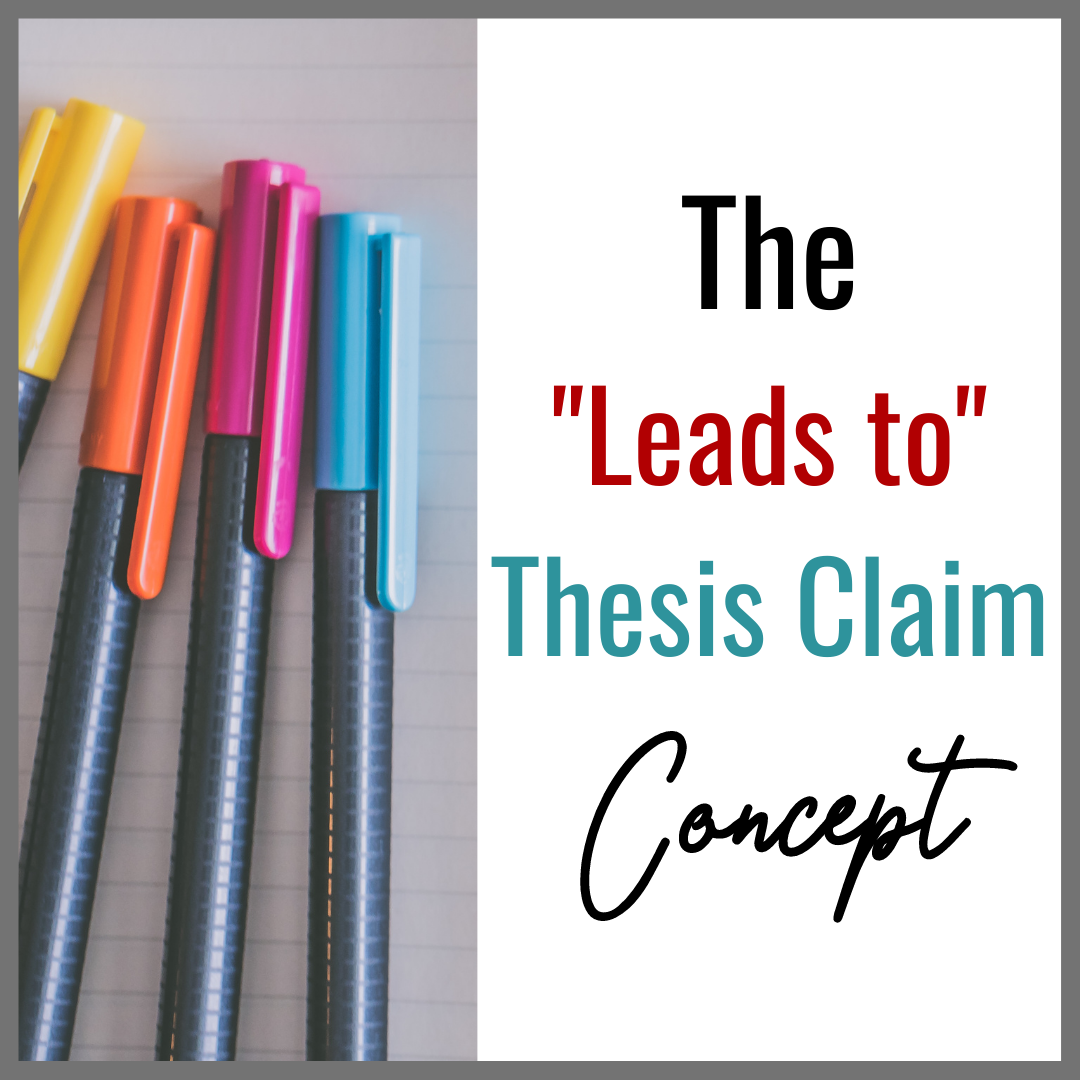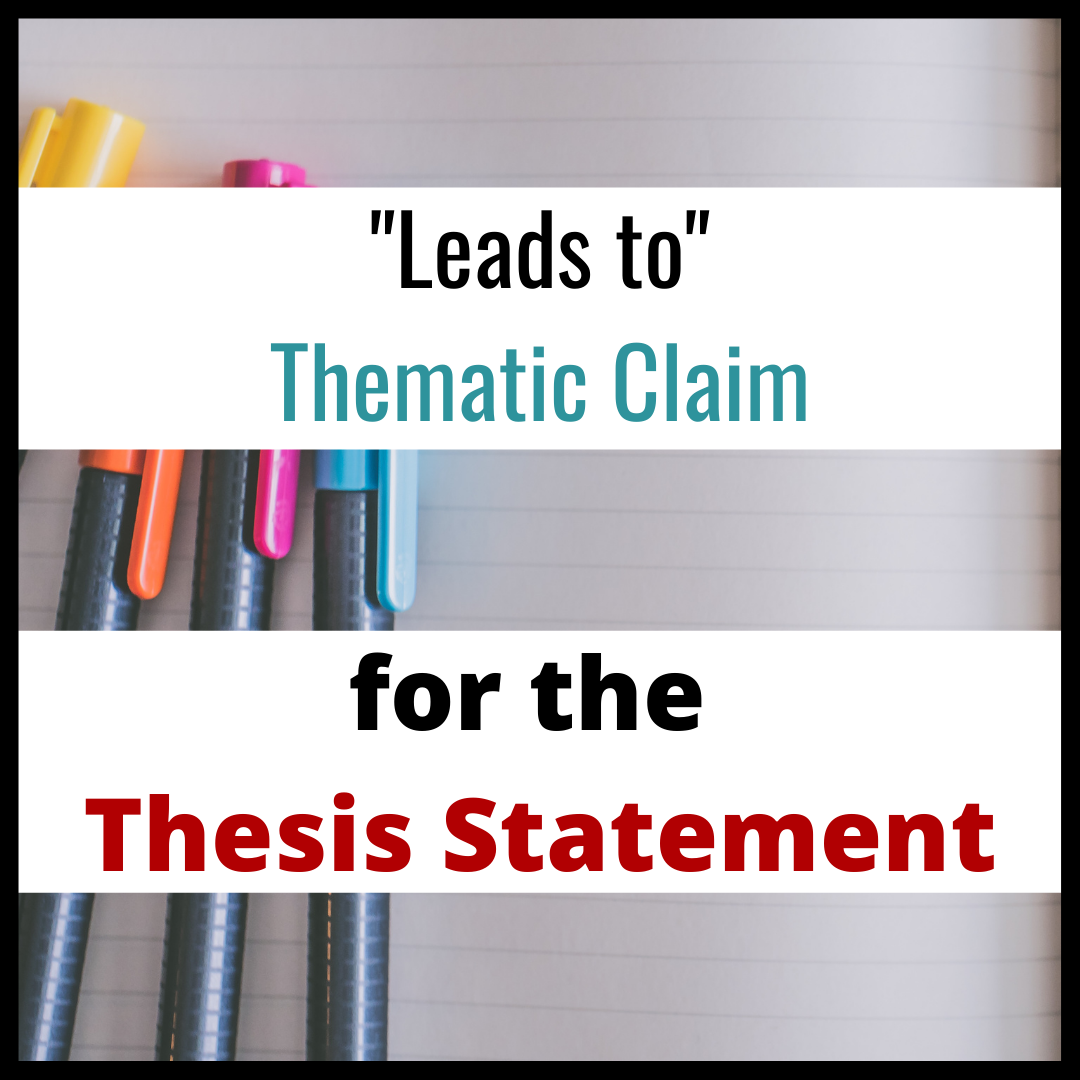The thesis statement is undoubtedly the MOST important sentence of the entire essay! It serves as the blueprint, or road map, for the essay, so it is crucial that the thesis statement is clear and logical before beginning the body of the essay. The caveat here, of course, is that a thesis statement can and often does change throughout the writing process, but in general, it is always helpful to begin with a solid argument.
We all know as English teachers that a fully developed thesis statement has two basic parts. These parts can span across one or two sentences (or more), but the thesis statement must have these two basic components in order to construct a clear outline for the direction of the essay: the claim and the evidence. (For higher-level students, I would also add in a warrant as needed).
Part One: The Claim
This is the part of the thesis statement that contains the opinion, which for the literary analysis essay, is the interpretation of the piece of literature. This interpretation should come in the form of a theme statement and should be a universal message about life in general.
Example Claims:
Love leads to loss.
Ambition leads to corruption.
Lack of enforcing laws leads to corrupt values.
Part Two: The Evidence
This is the part of the thesis statement in which the writer mentions the specific pieces of evidence will be discussed to prove the claim. For the literary analysis essay, the evidence should include the literary devices (elements or techniques) that will be used to prove the thematic claim (interpretation of the text).
The “Leads to” Claim
At one point in time, I took creative writing graduate classes and ended up in a class on writing dramas (or stage plays). During this class, we read the book The Art of Dramatic Writing by Lajos Egri. You can click here to find a copy of this book. In Egri’s book, he discusses the importance of consciously constructing a piece of creative writing around a central theme (what he calls a “premise”) and making decisions within the construction of the story arc that will communicate that theme.
While creative writing is the practice of constructing a thematic message, the literary analyst’s job is to deconstruct that message. One of my students calls the literary analysis process “Theme Redux.” The essential concept here is that creative writers use literary devices to build a thematic message. This creative and construction process may be conscious or subconscious. However, on some level, the writer heads in a direction (or directions) with the message. According to Lajos Egri, a creative writer can construct a thematic message in a “leads to” format because it inherently reflects the essential growth of a story. As I like to say, “Growth is essential to story.” I keep this quote on my board all year long.
The “leads to” format reflects the growth process because it implies the cause/effect arc within a story. For example, in Romeo and Juliet, one of Shakespeare’s themes can be interpreted to be “overly passionate love leads to loss.” The implications of this theme statement are that the characters will evidence (and we know that they do) too much passion that results in their tragic deaths. So, as a creative writer, someone like Shakespeare can construct a story along this growth arc. Essentially, the “leads to” theme statement grants the creative writer a blueprint, a true north, to follow during the writing process. It also helps the writer to avoid mixed messages that may be too difficult or too confusing for a reader (or viewer) to decipher.
After I came across this concept, I had an Aha! Moment! I realized that this was a tool that could be used not only for the construction process but also for the deconstruction process. By using the “leads to” structure for the theme statement, the literary analyst takes the theme beyond the obvious and narrows it into a more focused, arguable claim. The “leads to” strategy prevents the writer from beginning with a shallow argument and also gives the writer a cause / effect structure that is helpful in formatting the literary analysis essay.
For example, the theme statement “ambition leads to corruption” as an interpretation of Shakespeare’s play Macbeth helps to outline the essay into two parts: 1) how the character shows ambition, 2) how ambition becomes corrupt. Using this structure helps students to keep the argument focused and also helps to prevent some of the digression that can occur during the writing process.
This is also an effective strategy that helps students organize the direction of an essay on exams such as the SAT, ACT, AP, and the PARCC. Students can quickly arrive at a “leads to” thematic claim to argue in an essay. To avoid oversimplifying the wording, students can go back and change this wording later on during the revision and editing stages of the writing process to something more sophisticated. However, I have seen my students use this strategy with success across all levels from On-level to Advanced Placement and Dual Credit.
Sample “Leads to” Claims
Let’s look at some more “leads to” thematic claims for other classic texts to see this concept in action. Please note that great works of literature do not have only ONE correct thematic claim. I always emphasize with my students that with literary analysis, there are LOTS of ways to interpret a text “correctly” although a person can also be incorrect and misinterpret a text. The examples below show a possible thematic claim in a “leads to” format for each text.
Lord of the Flies: A lack of civilization leads to disorder and chaos.
Beowulf: A show of pride leads to victory over evil.
The Metamorphosis: Random acts in life lead to paralysis.
Brave New World: Attempts to control society through pleasure lead to disillusionment.
To Kill a Mockingbird: Judging appearances leads to misjudging others.
The Scarlet Letter: Keeping secrets leads to silent suffering.
Julius Caesar: Too much loyalty leads to reckless acts.
Animal Farm: Inequality leads to unhappiness.
The Odyssey: Persevering through hardships leads to ultimate victory.
Frankenstein: Using science to manipulate life leads to disastrous consequences for society.
What other “leads to” thesis statements can you think of?
Share in the comments. I’d love to hear from you!
Related Resource
If you’d like to use this concept with your students, check out the Bespoke ELA Thesis Statement Mini-lesson here. This mini-lesson series is also part of the best-selling Literary Analysis Mega Bundle book by Bespoke ELA found here.
See what other teachers are saying about this book of step-by-step mini-lessons for teaching the literary analysis essay:
“I have used this with my 10th and 11th grade students over the past few years, and I am amazed at how easy it is to teach but more at how well the students grasp the content! Their writing has improved immensely! Thank you!”
“This transformed the way that I teach thesis writing and literary analysis essays. The lessons were easy to follow, went step-by-step, and really helped my students to understand not only how to identify good writing but how to incorporate the steps into their own writing. I highly recommend this resource.”
“This immense resource provides the teacher with everything necessary to teach a literary analysis essay in a fun, yet challenging way. I saw a lot of improvements in my students' writing after doing just a few of the activities in this resource.”
Free Resource
Pick up this free resource by subscribing to the Bespoke ELA blog to receive the password that will unlock the Freebie Library. Click here to subscribe. If you are already a member, click here to login to the library directly.
About the Author
Meredith is the founder and creator of TeachWriting.org and Bespoke ELA. She has taught high school English for 10+ years in Dallas, Chicago, and New York City and holds a M.A. in Literature from Northwestern University. She has always had a connection to the written word-- through songwriting, screenplay writing, and essay writing-- and she enjoys the process of teaching students how to express their ideas. Meredith enjoys life with her sweet daughter and Yorkie.








